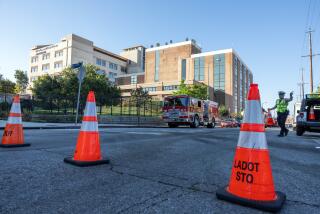Two Security Gaps Reported at San Onofre
- Share via
A federal review of safety at the San Onofre nuclear plant has found that two security breaches occurred in the weeks after the Sept. 11 terrorist attacks, but that overall security is good.
On Oct. 9, U.S. Nuclear Regulatory Commission inspectors found two unescorted visitors trying to use a visitor badge on an automatic security device to gain access to the control room. When questioned, they said they were trying to rejoin their escort. The inspectors told them they did not have security clearance to enter the control room, and remained with them until the escort returned.
About three weeks later, inspectors watched a security guard search a plant firetruck that was about to enter a protected area for a fire drill. The guard performed a cursory pat-down of a duffel bag and moved on. “Security personnel failed, until prompted by inspectors, to perform a complete search of a station firetruck,” the report says.
The San Onofre Nuclear Generating Station, which is operated by Southern California Edison, has two 1,120-megawatt reactors at its plant just south of San Clemente that provide energy for 2.2 million homes from Santa Barbara to San Diego. A third, older reactor is being decommissioned.
Federal inspection reports said both errors were of minimal concern. San Onofre officials said they regret the mistakes, but urged the public to remember the many successful truck searches and visitor tours.
“Taken as an isolated incident, it has one appearance,” said Ray Golden, plant spokesman, “but when you look at the overall program ... we’re searching hundreds of trucks a month without these types of shortcomings.”
Industry watchdogs were appalled.
“If the private utility, at its highest state of alert and with [NRC] inspectors physically on the grounds, still lets unescorted visitors into protected areas and fails to adequately check vehicles, we’re in a lot of trouble,” said Daniel Hirsch, director of the Los Angeles-based Committee to Bridge the Gap and former director of the Adlai Stevenson program on nuclear policy at UC Santa Cruz.
Since Sept. 11, San Onofre and the nation’s other 102 nuclear power plants have been on the highest stage of alert. That means armed security guards greet plant employees and visitors, public access to sensitive areas has been discontinued, and technical information has been taken off the plant’s Web site. At the time, plant spokesmen said security at the plant was ultra-tight.
The report says inspectors determined both incidents had a credible impact on safety, but according to a formula used by the NRC, were later categorized as the most minor of breaches.
Golden declined to say whether the employees involved were disciplined.
Still, the NRC reported in a March 4 assessment of security from April 1 to Dec. 31, 2001, that overall, the plant’s operations preserved public safety and met federal goals.
Nuclear activists say the agency is not taking security seriously enough.
“They certainly seem to be downplaying these things,” said Steven Dolley, research director of the Nuclear Control Institute in Washington. “I don’t think you can rely on such issues being treated rationally and seriously all the time by the NRC.”
Hirsch said such incidents show the need for a bill by Sen. Harry Reid (D-Nev.) to federalize nuclear power plant security.
“It underscores the need to have security taken over by forces capable of dealing with terrorists,” he said.
NRC and Edison officials will discuss the security assessment at a public meeting at 7 p.m. Tuesday at the San Clemente Inn, 2600 Avenida del Presidente.
More to Read
Sign up for Essential California
The most important California stories and recommendations in your inbox every morning.
You may occasionally receive promotional content from the Los Angeles Times.














